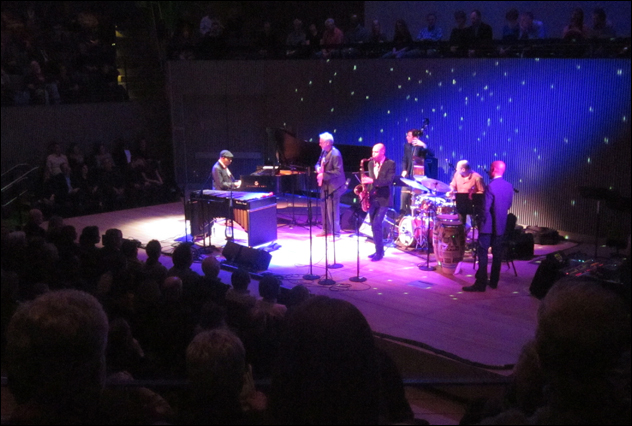

By now, perhaps you’ve heard about, read about or even seen the construction of the new SFJAZZ Center on the corner of Franklin and Fell Streets in San Francisco. Now complete, the 35,000-sq.-ft. building is poised to redefine live jazz in the Bay Area, as it’s funded largely by private donations and handily dispenses with the tables-and-waitresses, two-drink minimum nightclub model.
After the SFJAZZ Center was announced, entirely valid concerns rose about the “museumification” of jazz. Jazz has always thrived in nightclubs—or, for that matter, seedy bars. Charles Mingus’ famous remarks about nightclub chatter notwithstanding, a certain amount of cultural globetrotting is present when the blues is played on the stage of a $64 million performing arts center.
I’m happy to report that the SFJAZZ Center strikes just the right balance between nightclub and theater. Cup holders allow the audience to bring drinks in from the bar, but nobody drops a credit card tray in front of you while the headliner is in the middle of a particularly engrossing solo. The sound, notably, is stunning, thanks to architect Mark Cavagnero and acoustician Sam Berkow. And as a mini-amphitheater set in the semi-round, with a steeply raked floor, the hall is very intimate—capacity is 700, but feels much smaller than that. There are no seats further than 50 feet from the stage.


In addition to intimacy, the building adheres to a theme of transparency. The lobby is black-and-grey modern, with floor-to-ceiling glass walls looking out to the street. A smaller 80-seat recital hall will have the same feature, so that passersby on the sidewalk can watch from the street. Finally, the balcony terrace overlooking Fell Street includes a view rare to jazz clubs—or to any club, theater or performing center, for that matter: the backstage room of the performers, who are openly visible to the public through a set of glass doors.
Upstairs, a large mural by Sandow Birk and Elyse Pignolet depict famous jazz sites from the San Francisco of yore (Bop City, Club Flamingo, Champagne Supper Club, Melrose Record Shop) as well as those that still remain (The Fillmore, Bimbo’s); another covers jazz landmarks in New York City. But the jazz of the present thrives on the stage, and the rest of the season’s programming is decidedly varied. In May, Jason Moran plans two concerts with the first five rows of seats removed to make room for live skateboarders on a halfpipe, while Dave Holland, Patricia Barber, Mariza, the Afro-Cuban All-Stars, Ute Lemper, Brad Mehldau and others offer styles of every imaginable stripe.


The center’s opening week has been a celebrity-studded affair. On opening night, Bill Cosby brought his trademark bumbling style as MC, with Esperanza Spalding, Chick Corea, Joe Lovano, Bobby Hutcherson and John Handy joining other luminaries who are here throughout the week. That grand-opening concert, streamed live on NPR, might have offered star power, but Friday night’s concert provided more moments of sheer transcendence.
To wit: Never did I imagine I needed to hear another version of Stevie Wonder’s “Higher Ground,” but the version that closed the first set resulted in an immediate and deserved standing ovation. Matt Penman’s staccato bass line and Moran’s angular piano comping underscored a tremendous vibraphone solo by Stefon Harris that ended in a Ginseng flurry. Regina Carter dealt in delicate harmonics and a thrilling middle-eastern solo of voice and violin in unison, and Eric Harland and John Santos traded off on percussive ESP to bring the fully reworked song to a crashing halt.
As each song featured a different group, the concert was a jazz smorgasbord of the best kind—especially because drummer Harland played so often. After his talent and imagination on display Friday night, including a dizzying, propulsive duet with Moran of Fats Waller’s “Yacht Club Swing,” it is safe to call Eric Harland the greatest drummer in jazz right now. When McCoy Tyner paid a surprise visit to the stage for his compositions “Blues on the Corner” and “Fly With the Wind,” Harland thundered through incredible solos; equally as important, it was Harland more than anyone else on stage who was able to lock in step with the veteran pianist.


Subtle moments included a taseful duet between Bill Frisell and Joshua Redman, joined at the brain, on the lesser-performed Thelonious Monk tune “Pannonica,” and a time-stopping “I Thought About You,” courtesy of Mary Stallings, who happened to grow up four blocks from the new venue. The Johnny Mercer-Jimmy Van Heusen song, sung in quintessential closing-time style with pianist Eric Reed, allowed Stallings’ voice to showcase the room’s sound system to great effect. When Stallings sang lines like “I passed a shadowy laaannnne…,” the microphones picked up every lingering vibration in the back of her throat long after the vowel had passed.
But the new SFJAZZ Center shined brightest when the sound system was shut off entirely. To close the set, the five resident artistic directors—Bill Frisell, Jason Moran, Regina Carter, John Santos and Miguel Zenón—played a warm, romantic tango, unamplified, together on stage. The purity and crispness of tone hung in the air, sending an audience flush with the thrill of great jazz out into the streets of a city that, after this week, simply won’t be the same.
For a full upcoming schedule, see SFJAZZ.org.
.Live Review: The SFJAZZ Center Opens With Style, Intimacy, and Stars in San Francisco












